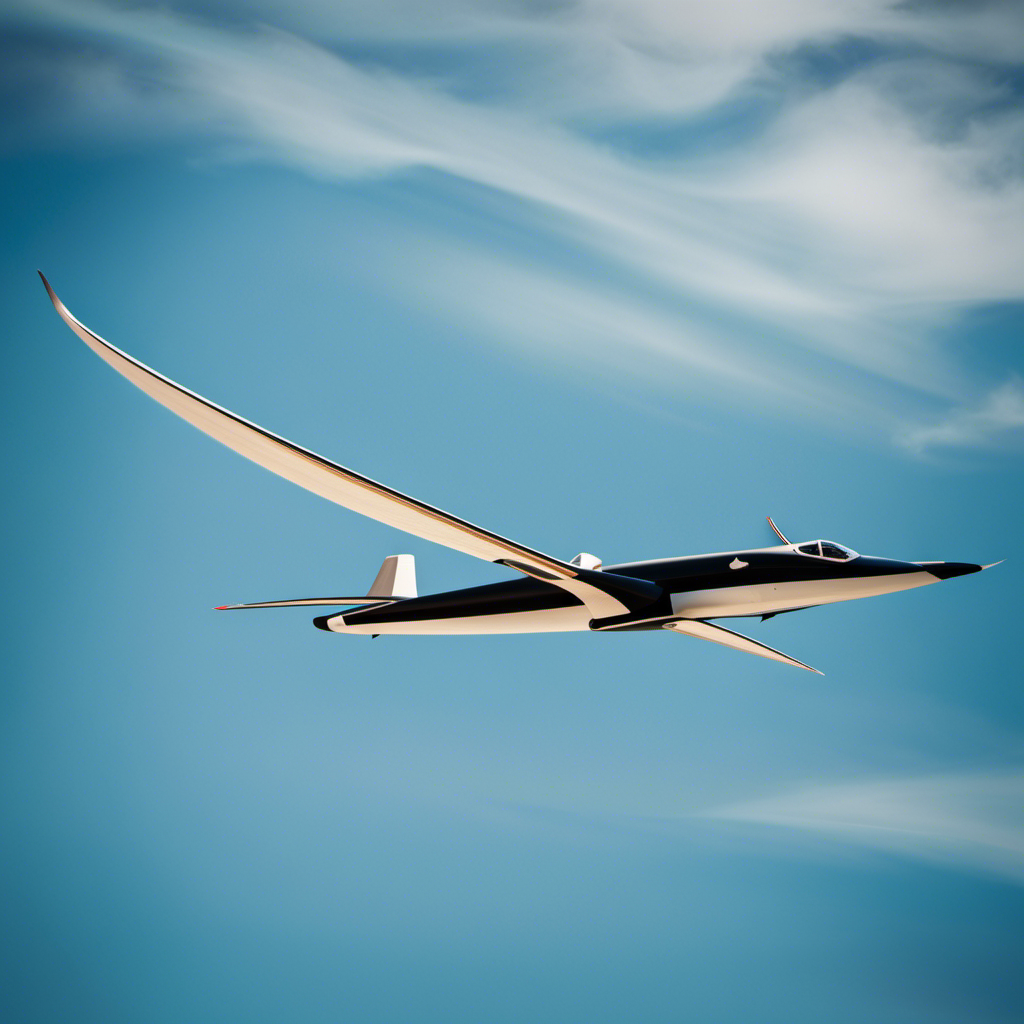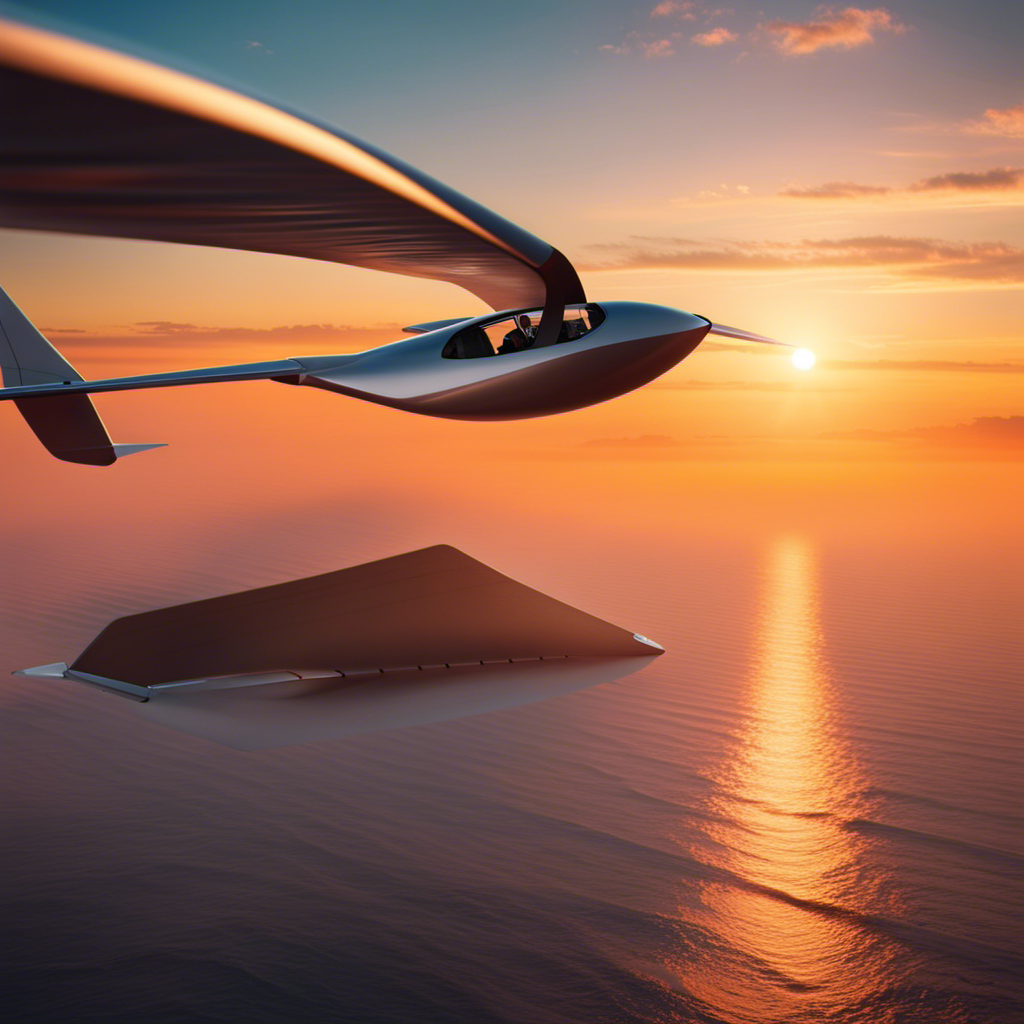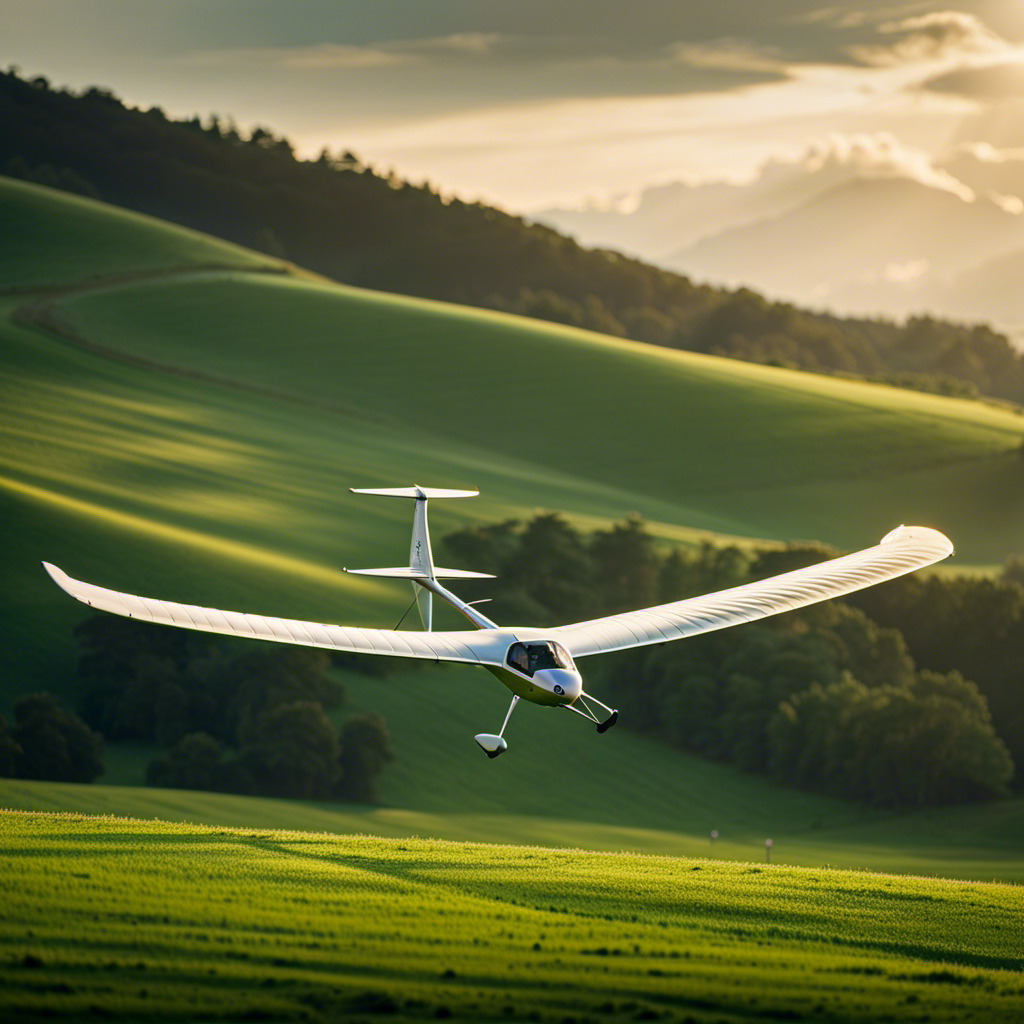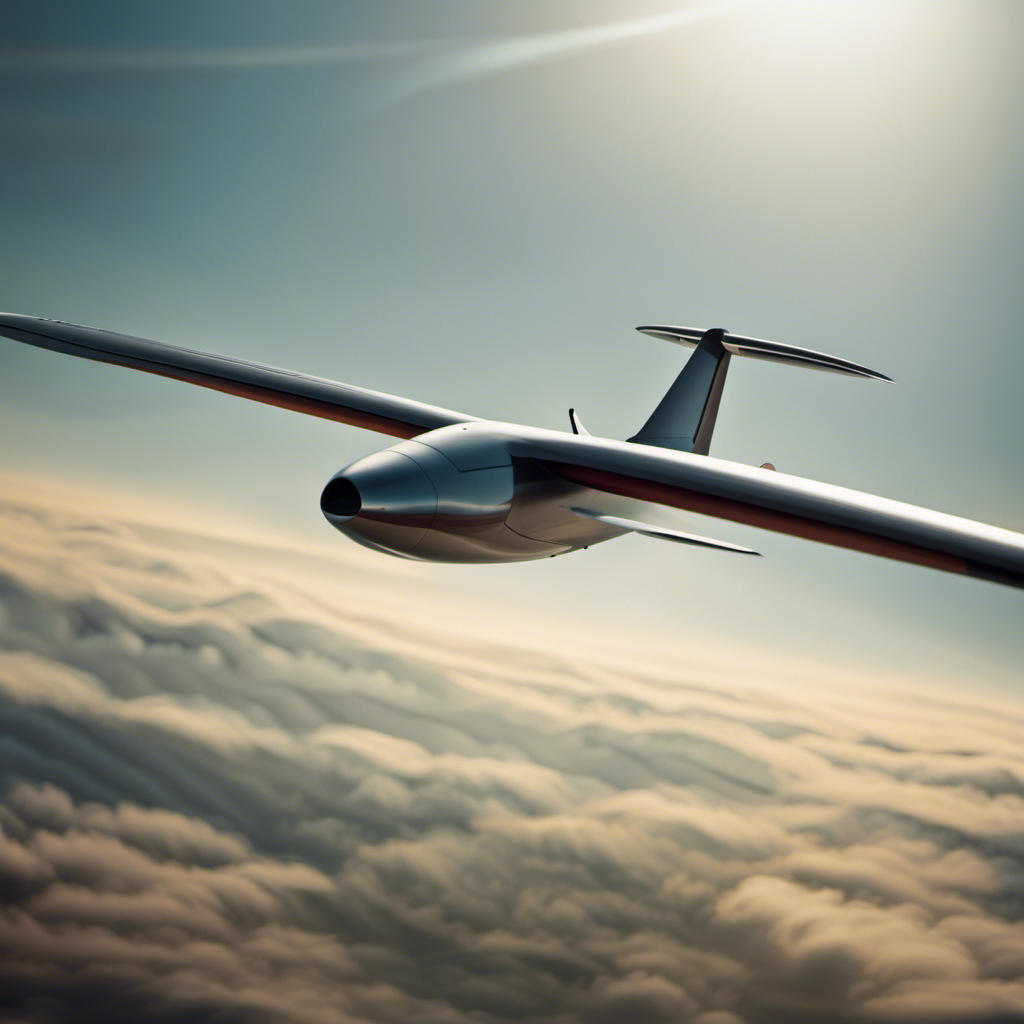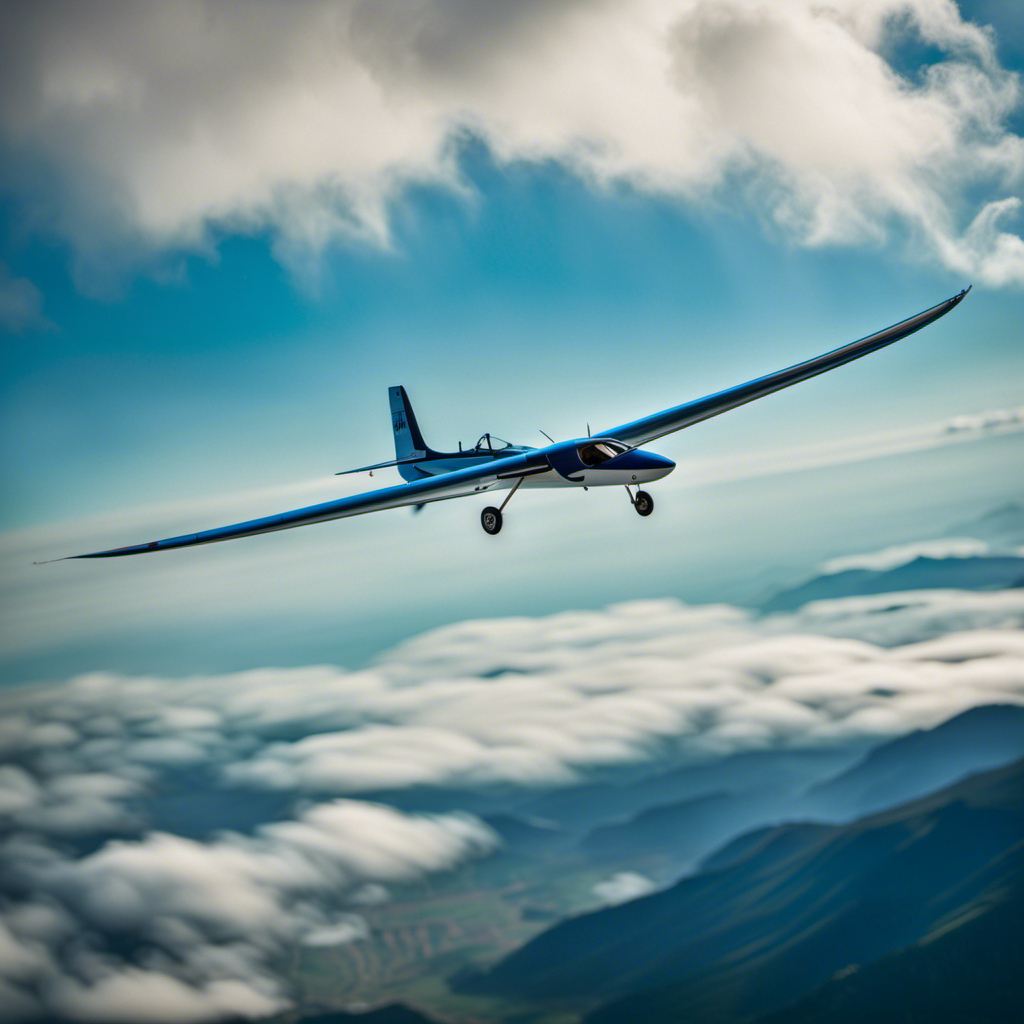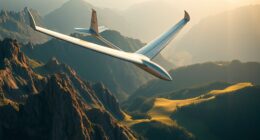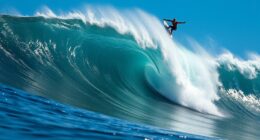Imagine yourself soaring through the skies, free and unrestricted, while you become proficient in piloting a sailplane.
In this article, we will delve into the fascinating world of plane gliders, uncovering the principles of aerodynamics and exploring how these remarkable machines achieve flight.
From understanding the cockpit and controls to learning about safety precautions and training, we’ll leave no stone unturned.
So join us on this exhilarating journey as we unravel the basics and mechanics of the plane glider.
Key Takeaways
- Famous plane glider records and competitions showcase the potential and endurance of plane gliders.
- Advancements in technology and design, such as lightweight materials and improved wing design, contribute to the performance and efficiency of plane gliders.
- Joining the gliding community involves finding gliding clubs and schools for necessary training and resources.
- Personal experiences and testimonials from pilots provide valuable insight into the challenges, techniques, and performance of plane gliders.
The Principles of Aerodynamics
The principles of aerodynamics explain how air flows over the wings of a plane glider, allowing it to stay aloft. Understanding these principles is crucial to comprehend the mechanics of flight.
The shape of the wing, known as the airfoil, plays a significant role. Its curved upper surface and flat lower surface cause the air to move faster above the wing, creating a lower pressure. This pressure difference generates lift, which counteracts the force of gravity and keeps the plane glider in the air.
Additionally, the angle of attack, the angle between the wing’s chord line and the oncoming airflow, affects lift and drag. By adjusting the angle of attack, the pilot can control the glider’s flight characteristics.
Now, let’s delve into how plane gliders achieve flight without relying on an engine.
How Plane Gliders Achieve Flight
To achieve flight, plane gliders rely on the principles of aerodynamics and use the shape of their wings to generate lift. The wings of a plane glider are designed in such a way that the air passing over the top of the wing moves faster than the air passing underneath. This creates a pressure difference, with lower pressure on top and higher pressure below, resulting in lift. The shape of the wing, called an airfoil, plays a crucial role in this process. The upper surface of the wing is curved, while the lower surface is relatively flat. This asymmetrical shape allows the air to flow smoothly over the wing, reducing drag and increasing lift. By understanding these principles, plane gliders are able to achieve flight and glide through the air effortlessly.
| Column 1 | Column 2 | Column 3 |
|---|---|---|
| Lift | Drag | Weight |
| Thrust | Glide | Airfoil |
| Wing | Aerodynamics | Glide ratio |
| High Pressure | Low Pressure | Airflow |
| Airflow | Lift-to-Drag Ratio | Glide Path |
With the understanding of how plane gliders achieve flight, let’s delve into the different types of plane gliders and the unique features they possess.
Types of Plane Gliders
Explore the different types of plane gliders and discover their distinctive features. Plane gliders come in various designs, each tailored for specific purposes and flight characteristics. Here are four types of plane gliders you should know about:
-
Standard Class Gliders: These gliders are versatile and offer a balanced performance. They are designed for cross-country flying and competition.
-
Open Class Gliders: With their sleek and high-performance design, open class gliders are built for speed and long-distance flights. They often feature advanced aerodynamic features and have a higher glide ratio.
-
Motor Gliders: Combining the benefits of gliders and powered aircraft, motor gliders have an engine that can be used to take off and gain altitude. Once in the air, the engine can be switched off for soaring.
-
Ultralight Gliders: These gliders are lightweight and compact, making them easy to transport and launch. They are ideal for recreational flying and training purposes.
Understanding the different types of plane gliders is crucial for choosing the right one for your needs. Now, let’s delve into the next section and explore the cockpit and controls of these remarkable aircraft.
Understanding the Cockpit and Controls
Now let’s take a closer look at how the cockpit and controls of these remarkable aircraft work.
When you step into the cockpit of a glider, you’ll notice a few key components. First, there’s the control stick, also known as the joystick. This stick allows you to control the glider’s pitch and roll, giving you precise control over its movements. Connected to the control stick are the ailerons, which are small movable surfaces on the wings that help with banking and turning.
Additionally, you’ll find the rudder pedals, which control the glider’s yaw. These pedals allow you to coordinate your turns and maintain stability. The cockpit also houses various instruments such as altimeters, airspeed indicators, and variometers, which provide you with crucial information about the glider’s altitude, speed, and rate of climb or descent.
Understanding how to operate these controls and interpret the instruments is vital for a safe and successful flight.
Now, let’s move on to the next section and explore the importance of safety precautions and training in gliding.
Safety Precautions and Training
When you’re learning to glide, it’s important to prioritize safety by following proper precautions and receiving thorough training. Gliding can be an exhilarating experience, but it also comes with inherent risks. Before taking to the skies, ensure that you have the necessary knowledge and skills to handle a plane glider.
Start by enrolling in a reputable flight school that offers comprehensive training programs specifically designed for glider pilots. These programs will cover essential topics such as aerodynamics, meteorology, navigation, and emergency procedures. Additionally, make sure to familiarize yourself with the safety equipment and protocols specific to gliding, such as the use of parachutes, emergency locator transmitters, and radio communications.
By investing in proper training and adhering to safety precautions, you can minimize the risks associated with gliding and maximize your enjoyment of this incredible aviation sport.
Transitioning into the subsequent section about the advantages and limitations of plane gliders, it’s important to understand how these aircraft differ from other types of gliders.
Advantages and Limitations of Plane Gliders
To fully appreciate the advantages and limitations of using a plane glider, you should consider the unique capabilities and challenges that come with this type of aircraft.
-
Efficient Aerodynamics: Plane gliders are designed to have a high lift-to-drag ratio, allowing them to fly for extended periods with minimal energy consumption.
-
Quiet and Environmentally Friendly: Since plane gliders rely solely on the forces of nature, they produce no noise pollution or harmful emissions, making them an eco-friendly option for aviation enthusiasts.
-
Limited Range: Plane gliders have a limited range due to their inability to generate their own propulsion. They rely on thermal updrafts or towing to gain altitude and sustain flight.
-
Weather Dependency: Plane gliders are highly susceptible to weather conditions. Strong winds, turbulence, or lack of thermal activity can significantly impact their ability to stay aloft.
Understanding these advantages and limitations will give you a comprehensive understanding of the unique nature of plane gliders.
Now, let’s explore some famous plane glider records and competitions.
Famous Plane Glider Records and Competitions
If you’re interested in exploring the world of aviation competitions, there are several famous records that have been set by skilled pilots in the realm of plane gliding.
One such record is the absolute altitude record, which was set by Steve Fossett in 2006. Fossett reached an astonishing altitude of 15,460 meters in a glider, showcasing the incredible potential of these aircraft.
Another famous record is the distance covered in a straight line without landing, achieved by Klaus Ohlmann in 2003. Ohlmann managed to glide an astonishing distance of 1,932 kilometers, demonstrating the remarkable endurance of plane gliders.
These records push the boundaries of what is possible in the world of gliding and serve as inspiration for the future of plane gliders.
The Future of Plane Gliders
The future of plane gliders looks promising, with advancements in technology and design pushing the boundaries of what is possible.
Glider manufacturers are constantly striving to improve the performance and efficiency of these aircraft, resulting in exciting developments.
One area of focus is the use of lightweight materials, such as carbon fiber composites, to reduce the overall weight of the glider and enhance its aerodynamic capabilities.
Additionally, improvements in wing design, such as the implementation of winglets, allow for increased lift and reduced drag.
Another key aspect is the integration of advanced navigation and control systems, which enable pilots to optimize their flight paths and make more precise maneuvers.
These advancements will undoubtedly enhance the gliding experience, attracting more enthusiasts to join the gliding community and explore the thrill of soaring through the skies.
Joining the Gliding Community
If you’re interested in joining the gliding community, there are several key points to consider.
First, finding gliding clubs and schools in your area is crucial. These clubs and schools will provide you with the necessary training and resources to become a licensed glider pilot.
Once you have found a suitable club or school, the next step is to begin the process of becoming a licensed glider pilot. This typically involves completing a series of flight lessons, passing written exams, and meeting certain flight hour requirements.
Finding Gliding Clubs and Schools
Explore local directories and online resources to discover gliding clubs and schools near you. It is essential to find a reputable and well-established organization that can provide you with the necessary training and support.
Look for clubs that have experienced instructors and a variety of gliders available for training purposes. Consider factors such as the location of the club, the availability of facilities, and the cost of membership and training.
Additionally, take into account the club’s safety record and the overall reputation within the gliding community. By researching and selecting the right club or school, you will be setting yourself up for success in your journey to becoming a licensed glider pilot.
Becoming a Licensed Glider Pilot
To become a licensed glider pilot, you’ll need to complete the necessary training and pass a series of written and practical exams. The training will cover various topics, including aerodynamics, meteorology, navigation, and emergency procedures. You’ll learn how to operate the controls of a glider, perform pre-flight inspections, and execute takeoffs and landings. The written exams will test your knowledge of these subjects, while the practical exams will assess your ability to apply that knowledge in real flying situations. It’s important to note that the specific requirements for obtaining a glider pilot license may vary by country or jurisdiction. To give you an idea of the training process, here’s a table summarizing the typical steps involved:
| Step | Description |
|---|---|
| 1 | Ground School: Classroom instruction on theory and regulations |
| 2 | Solo Flight: Fly solo under the supervision of an instructor |
| 3 | Cross-Country Flights: Gain experience navigating and flying longer distances |
| 4 | Written Exam: Test your knowledge on glider operations and regulations |
| 5 | Practical Exam: Demonstrate your skills in a flight test |
Personal Experiences and Testimonials
You’ll find that personal experiences and testimonials can provide valuable insight into the world of plane gliding. Hearing from those who have actually flown a glider can give you a better understanding of what it’s like to be in the cockpit and how the aircraft performs in different conditions.
Pilots often share their experiences to help others learn from their successes and mistakes. For example, they may discuss the challenges of launching a glider, the techniques used for soaring, or the importance of reading weather conditions.
Testimonials can also provide information about specific glider models, their handling characteristics, and any modifications that have been made. By listening to personal experiences and testimonials, you can gain a more comprehensive understanding of the intricacies of plane gliding.
Conclusion
In conclusion, plane gliders have revolutionized the world of aviation. They have made the thrill of flight more accessible and eco-friendly. These gliders are a remarkable achievement in engineering, with their efficient aerodynamics and innovative designs. The future of plane gliders looks promising, with advancements in technology and materials constantly pushing the boundaries. So why wait? Don’t miss out on the opportunity to soar through the sky like a bird. Join the gliding community today and make your dreams take flight!
Orion, better known as “Jetstream,” is the voice that brings the stories of the skies to life. His fascination with aviation began at a young age, sparked by his father’s tales of flying and adventure. Orion’s journey into the world of gliding was serendipitous, and from the moment he took his first glider flight, he knew he had found his calling.
